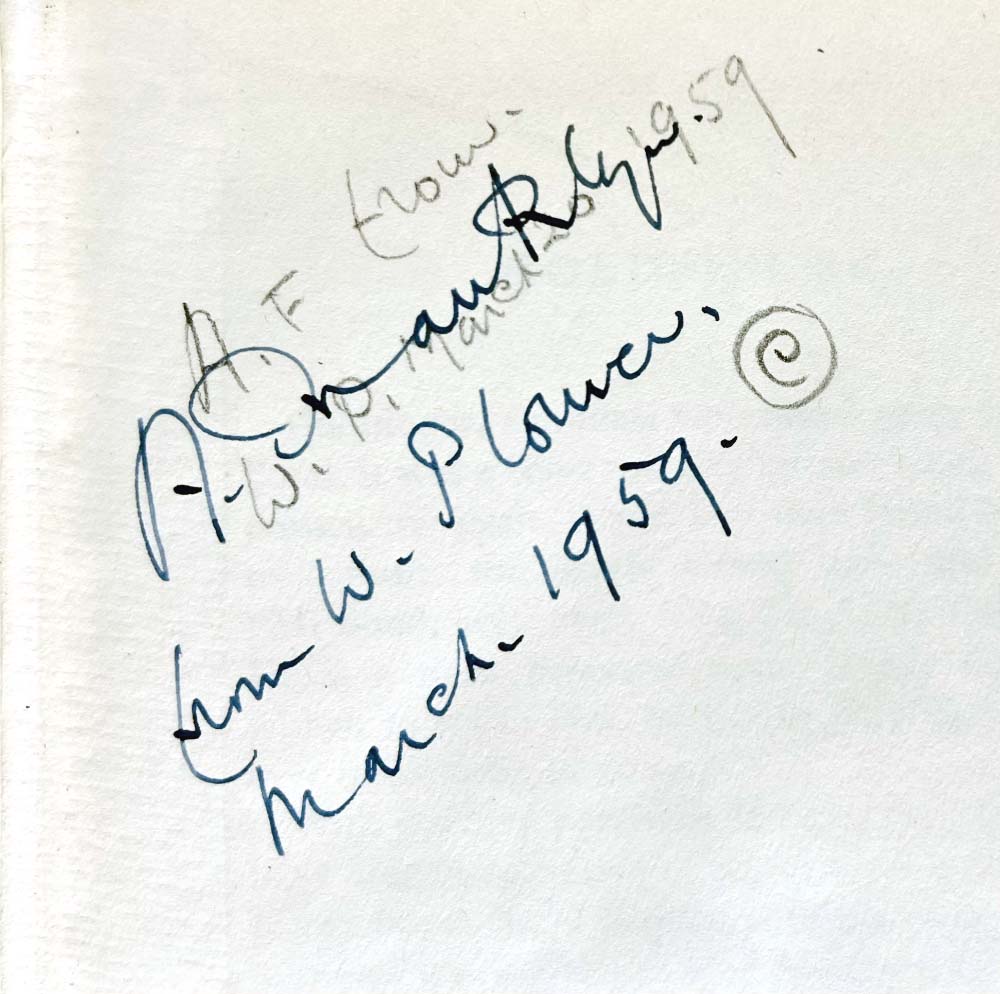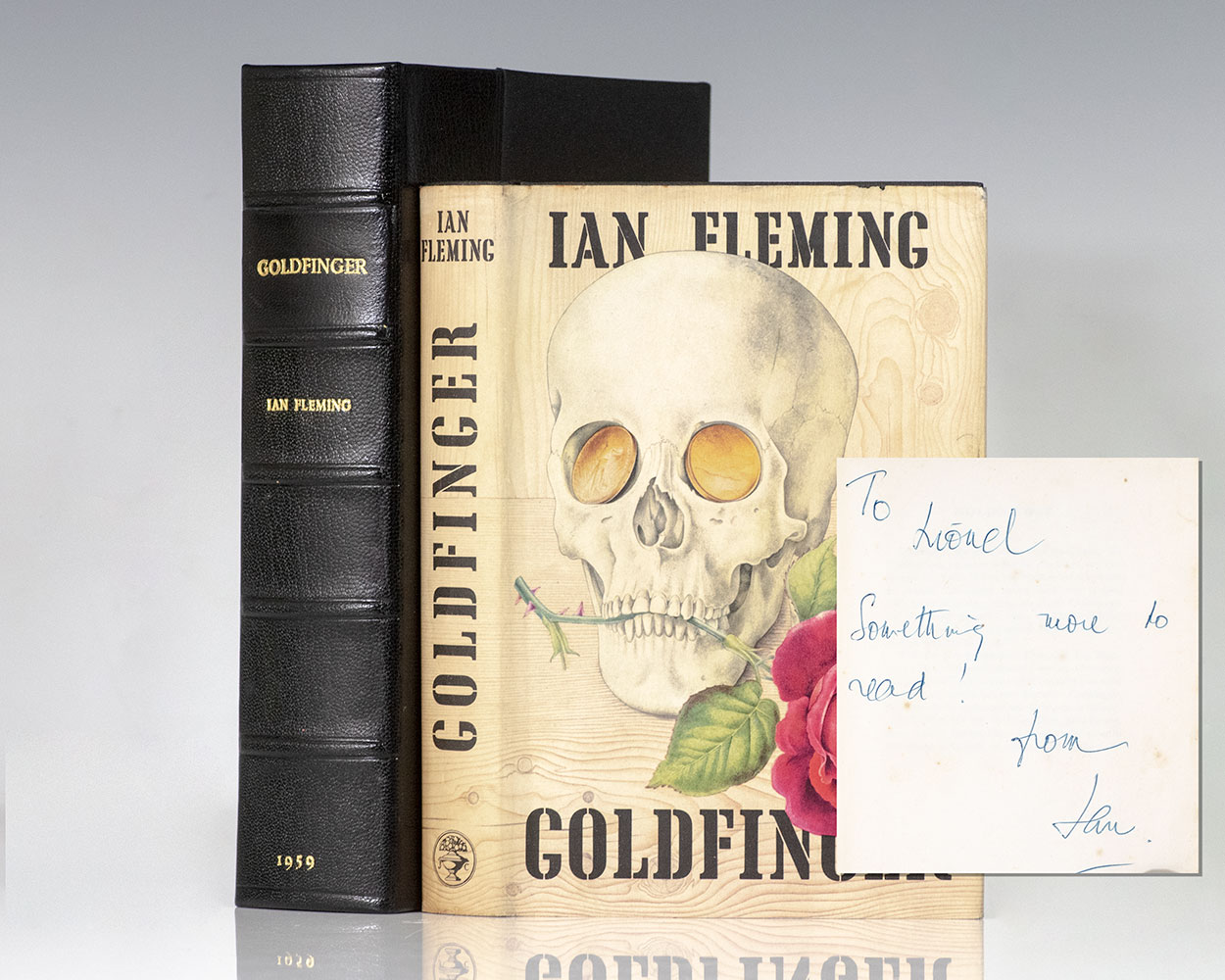Available Copies from Independent Booksellers

FLEMING, Ian Lancaster (1908-1964). Goldfinger. London: Jonathan Cape, 1959, 1959.
Price: US$9647.08 + shipping
Description: [Spy thriller] FIRST EDITION, variant binding with silver lettering, INSCRIBED BY THE DEDICATEE. Octavo (20 x 13cm), pp.318. An unusual pre-publication association/presentation copy with signed inscription by Ian Fleming's literary editor William Plomer. Publisher's black cloth-effect material over boards, with titles to spine in SILVER and 'skull' design to upper in gilt, pictorial dust-wrapper priced 15s. With ink note to flyleaf; A. Franklyn. / from W. Plomer. / March 1959. //. Housed in a custom-made clamshell box. Inscribed on 20th March (pencilled by the owner), three days before the date of release. Top edge slightly spotted else fine, similarly near fine jacket supplied, with minor wear to spine ends. An uncommon variant with silver rather than gold lettering to the backstrip, described in the bibliography as 'very occasionally [blocked] in silver'. William Plomer (1903-73), was a senior reader at Jonathan Cape Ltd., and one of Fleming's most trusted friends. He was instrumental in getting Casino Royale published and read and advised on each successive Fleming manuscript. He was unofficially Fleming's Editor-in Chief, and the novel Goldfinger is dedicated to him [Gilbert, p.650]. This important copy was later part of the comprehensive James Bond collection of bibliographer Jon Gilbert, with accompanying provenance. Gilbert, Jon: Ian Fleming The Bibliography, A7a (1.2), p.235, final line.
Seller: Adrian Harrington Ltd, PBFA, ABA, ILAB, Royal Tunbridge Wells, KENT, United Kingdom

Price: US$28941.24 + shipping
Description: Artwork measuring 406 x 508 mm. Matted within mountboard measuring 571 x 660 mm. In fine condition. Richard Chopping's personal, signed copy of the final proof sheet artwork, being the glorious full-sized image taken from the original painting, before the spine lettering and publisher's imprint were added (although the spine panel is still illustrated here). The image was then scaled down to produce the dust jackets. This item was originally sold in the 1980s by Richard Chopping himself. Richard Wasey Chopping (1917-2008) was a British illustrator and author, painting in the trompe l'oeil style to create a realistic and almost three-dimensional appearance. Among his illustrations are nine iconic covers for the James Bond books by Ian Fleming, published between 1957 and 1966, and the cover of John Gardner's first Bond continuation novel, Licence Renewed (1981). Chopping was born in Colchester, Essex and educated at Gresham's School, Holt, Norfolk. He lived in the historic village of Wivenhoe for over sixty years, founding an artist community which counted Francis Bacon as a member. The artwork for Goldfinger is one of the most famous of the series, and comprised a skull, with gold coins set in the eye sockets, with a rose between the teeth (flowers being a running theme that were used in four of Chopping's James Bond covers, with roses being chosen twice). From the significant Ian Fleming collection of Martin Schøyen (b.1940), whose private collection of manuscripts, which span all cultures and all time periods, is one of the largest and most comprehensive of its kind. The Schøyen Collection No. 64. Gilbert p.637.
Seller: Adrian Harrington Ltd, PBFA, ABA, ILAB, Royal Tunbridge Wells, KENT, United Kingdom

Fleming, Ian. Goldfinger.. Jonathan Cape, London, 1959.
Price: US$35000.00 + shipping
Description: First edition of the seventh novel in Ian Fleming's James Bond series. Octavo, original black cloth. Association copy, inscribed by the author on the front free endpaper, "To Lionel, Something more to read! From Ian." The recipient, Lionel Berry, 2nd Viscount Kemsley was a politician and newspaper editor. His father, the 1st Viscount Kemsley, had given Ian Fleming his first job as a journalist when he employed him as the Foreign Manager for the Kemsley newspaper group. It was this role, with its contracted three month break every winter to allow Fleming to holiday in Jamaica, that gave Fleming the opportunity to write the planned spy novel that would become Casino Royale. Near fine in a near fine dust jacket. Jacket design by Richard Chopping. Housed in a custom clamshell box. A nice association. Goldfinger originally bore the title The Richest Man in the World. Based upon American gold tycoon Charles W. Englehard, Fleming named his villain after British architect Erno Goldfinger. When the actual Goldfinger found out his name was being used, he threatened to sue Fleming, and the matter was ultimately settled out of court. A best-seller upon its release, it became the third James Bond film in 1964 starring Sean Connery.
Seller: Raptis Rare Books, Palm Beach, FL, U.S.A.

Fleming, Ian. Goldfinger.. Jonathan Cape, London, 1959.
Price: US$60000.00 + shipping
Description: First edition of the seventh novel in Ian Fleming's James Bond series. Octavo, original black cloth. Association copy, inscribed by the author on the front free endpaper, "To Una, who again wrote the whole thing! from Ian Fleming." The recipient, Una Trueblood, whose surname was later appropriated by Fleming for the character of Mary Trueblood in Dr. No. Una started working in 1948 at Kemsley Newspapers and The Sunday Times where she was soon appointed secretary to Ian Fleming, where he worked throughout the 1950s. She recalled that Fleming "always said he only wrote Casino Royale, the first Bond book, because he was on the plane to Jamaica and he read such a bad, boring thriller that he thought he could do better himself." He would write the Bond novels during his annual stays at Goldeneye, his home in Jamaica, thereafter sending the manuscript to Una for typing up. The character in Dr. No named after Una is Mary Trueblood, secretary to John Strangways, the head of the British Secret Service's Caribbean station, a position echoing that of Una to Fleming. Mary however met a gruesome end, stabbed to death. Recalling a visit to Una made in 2008 the writer Adam Thorpe noted that "The fictional Mary Trueblood has many features in common with her real-life namesake; she's described in Dr No (1958) as "elegant" (three times), "pretty" and a "good-looker." Near fine in a near fine dust jacket. Jacket design by Richard Chopping. Housed in a custom clamshell box. One of the finest association copies imaginable. Goldfinger originally bore the title The Richest Man in the World. Based upon American gold tycoon Charles W. Englehard, Fleming named his villain after British architect Erno Goldfinger. When the actual Goldfinger found out his name was being used, he threatened to sue Fleming, and the matter was ultimately settled out of court. A best-seller upon its release, it became the third James Bond film in 1964 starring Sean Connery.
Seller: Raptis Rare Books, Palm Beach, FL, U.S.A.